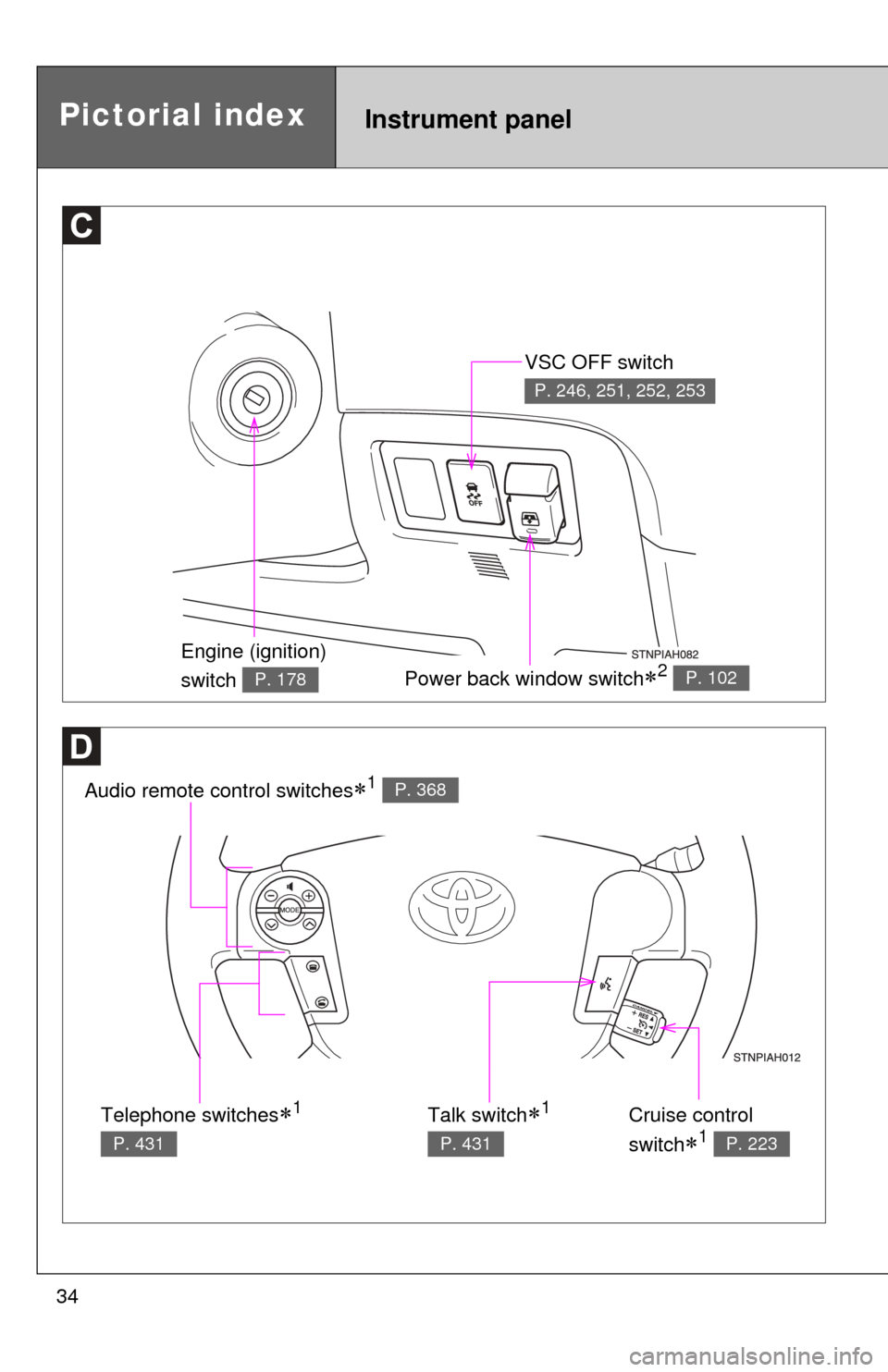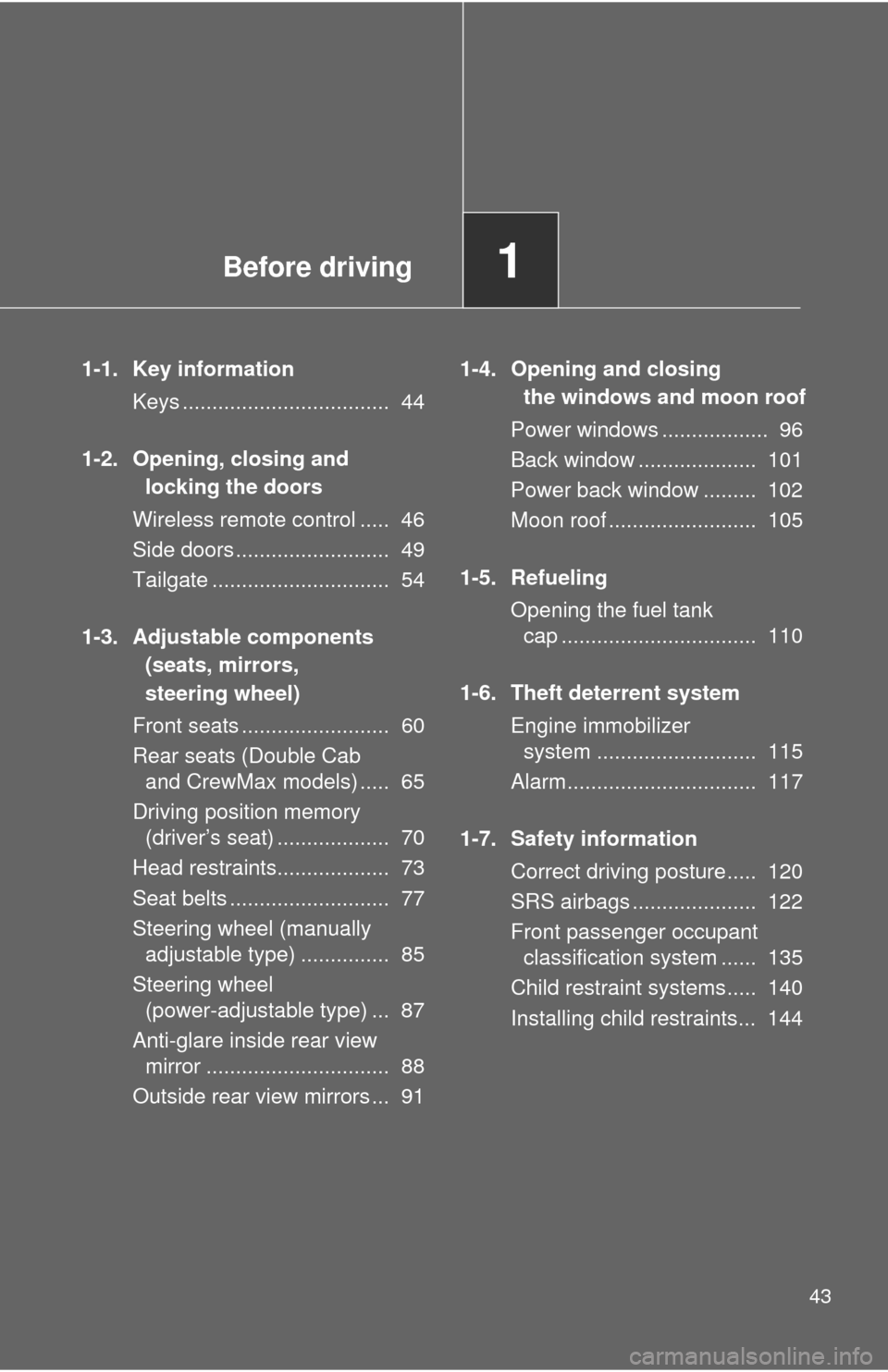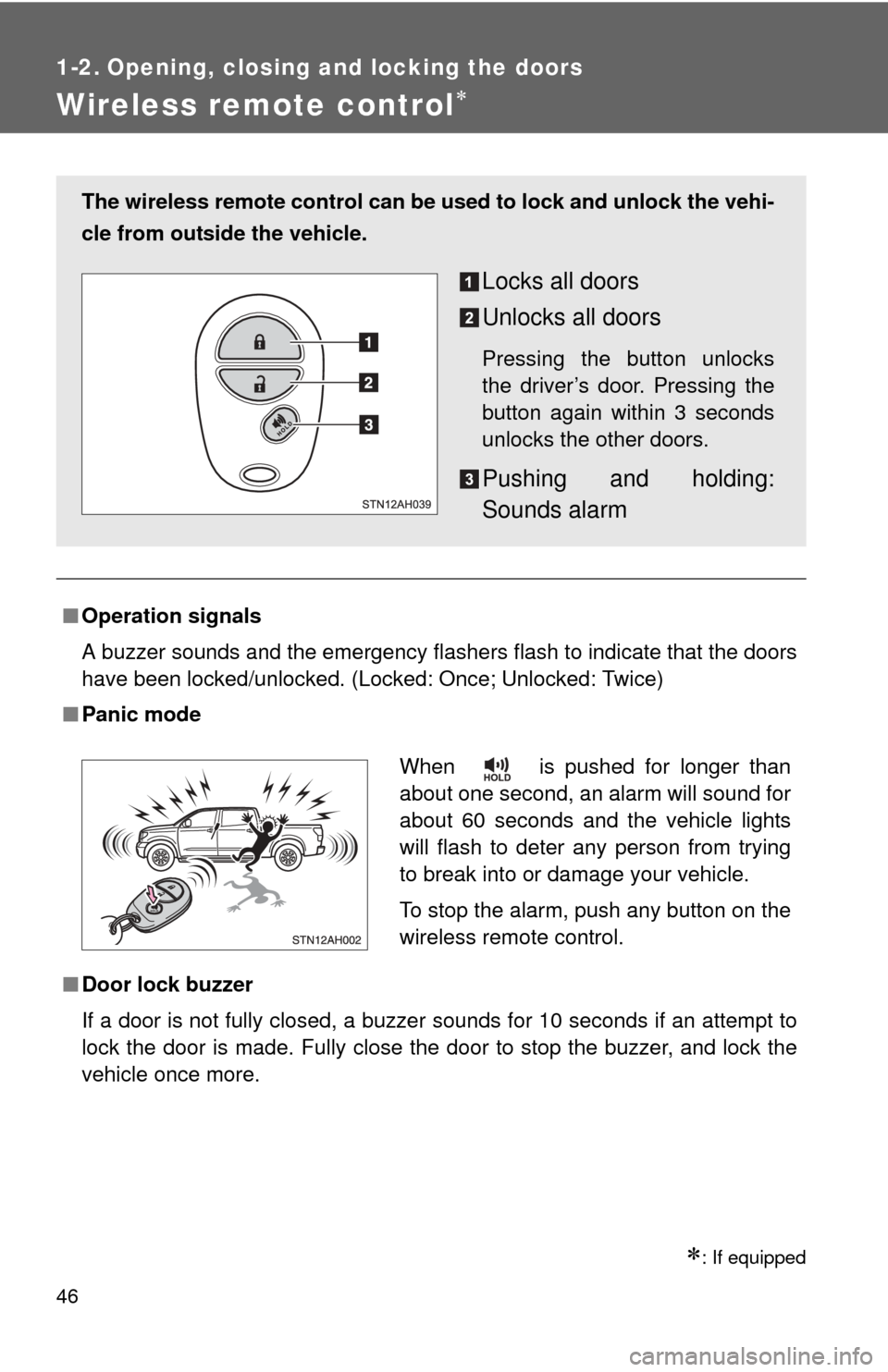2012 TOYOTA TUNDRA remote control
[x] Cancel search: remote controlPage 2 of 744

TABLE OF CONTENTSIndex
2
1-1. Key informationKeys ..................................... 44
1-2. Opening, closing and locking the doors
Wireless remote control ....... 46
Side doors ............................ 49
Tailgate ................................ 54
1-3. Adjustable components (seats, mirrors, steering
wheel)
Front seats ........................... 60
Rear seats (Double Cab and CrewMax models) ....... 65
Driving position memory (driver’s seat) ..................... 70
Head restraints ..................... 73
Seat belts ............................. 77
Steering wheel (manually adjustable type) .................. 85
Steering wheel (power-adjustable type)...... 87
Anti-glare inside rear view mirror .................................. 88
Outside rear view mirrors ..... 91
1-4. Opening and closing the windows and moon roof
Power windows .................... 96
Back window ...................... 101
Power back window ........... 102
Moon roof ........................... 105 1-5. Refueling
Opening the fuel tank cap... 110
1-6. Theft deterrent system Engine immobilizer system .............................. 115
Alarm .................................. 117
1-7. Safety information Correct driving posture ....... 120
SRS airbags ....................... 122
Front passenger occupant classification system ......... 135
Child restraint systems ....... 140
Installing child restraints ..... 144
2-1. Driving procedures Driving the vehicle .............. 168
Engine (ignition) switch....... 178
Automatic transmission ...... 181
Turn signal lever ................. 186
Parking brake ..................... 187
Horn .................................... 188
2-2. Instrument cluster Gauges and meters ............ 189
Indicators and warning lights ................................. 195
Multi-information display ..... 200
Accessory meter ................. 207
1Before driving
2When driving
Page 5 of 744

1
2
3
4
5
6
7
5
4-1. Maintenance and careCleaning and protecting the vehicle exterior............ 526
Cleaning and protecting the vehicle interior............. 529
4-2. Maintenance Maintenance requirements ..................... 532
General maintenance.......... 534
Emission inspection and maintenance (I/M)
programs........................... 537
4-3. Do-it-yourself maintenance Do-it-yourself service precautions ....................... 538
Hood ................................... 542
Engine compartment ........... 543
Tires .................................... 557
Tire inflation pressure ......... 565
Wheels ................................ 569
Air conditioning filter............ 572
Wireless remote control battery ............................... 575
Checking and replacing fuses ................................. 577
Light bulbs........................... 588 5-1. Essential information
Emergency flashers............ 600
If your vehicle needs to be towed........................... 601
If you think something is wrong ............................... 607
Fuel pump shut off system .............................. 608
5-2. Steps to take in an emergency If a warning light turns on or a warning buzzer
sounds... .......................... 609
If a warning message is displayed (vehicles
with multi-information
display) ............................. 619
If you have a flat tire ........... 623
If the engine will not start.... 641
If the shift lever cannot be shifted from P ................... 643
If you lose your keys........... 646
If the vehicle battery is discharged........................ 647
If your vehicle overheats .... 651
If the vehicle becomes stuck ................................. 654
If your vehicle has to be stopped in
an emergency .................. 655
4Maintenance and care5When trouble arises
Page 34 of 744

34
Instrument panelPictorial index
VSC OFF switch
P. 246, 251, 252, 253
Audio remote control switches1 P. 368
Power back window switch2 P. 102
Talk switch1
P. 431
Cruise control
switch
1 P. 223
Telephone switches1
P. 431
Engine (ignition)
switch
P. 178
Page 37 of 744

37
Installation of a mobile two-way radio system
The installation of a mobile two-way radio system in your vehicle could affect
electronic systems such as:
●Multiport fuel injection system/sequential multiport fuel injection system
● Cruise control system
● Anti-lock brake system
● SRS airbag system
● Seat belt pretensioner system
Be sure to check with your Toyota dealer for precautionary measures or spe-
cial instructions regarding installation of a mobile two-way radio system.
Scrapping your Toyota
The SRS airbag and seat belt pretensioner devices in your Toyota contain
explosive chemicals. If the vehicle is scrapped with the airbags and seat belt
pretensioners left as they are, this may cause an accident such as fire. Be
sure to have the systems of the SRS airbag and seat belt pretensioner
removed and disposed of by a qualified service shop or by your Toyota
dealer before you scrap your vehicle.
Perchlorate Material
Special handling may apply,
See www.dtsc.ca.gov/hazardouswaste/perchlorate.
Your vehicle has components that may contain perchlorate. These compo-
nents may include airbag, seat belt pretensioners, and wireless remote con-
trol batteries.
Page 43 of 744

Before driving1
43
1-1. Key informationKeys ................................... 44
1-2. Opening, closing and locking the doors
Wireless remote control ..... 46
Side doors .......................... 49
Tailgate .............................. 54
1-3. Adjustable components (seats, mirrors,
steering wheel)
Front seats ......................... 60
Rear seats (Double Cab and CrewMax models) ..... 65
Driving position memory (driver’s seat) ................... 70
Head restraints................... 73
Seat belts ........................... 77
Steering wheel (manually adjustable type) ............... 85
Steering wheel (power-adjustable type) ... 87
Anti-glare inside rear view mirror ............................... 88
Outside rear view mirrors ... 91 1-4. Opening and closing
the windows and moon roof
Power windows .................. 96
Back window .................... 101
Power back window ......... 102
Moon roof ......................... 105
1-5. Refueling Opening the fuel tank cap ................................. 110
1-6. Theft deterrent system Engine immobilizer system ........................... 115
Alarm................................ 117
1-7. Safety information Correct driving posture..... 120
SRS airbags ..................... 122
Front passenger occupant classification system ...... 135
Child restraint systems..... 140
Installing child restraints... 144
Page 46 of 744

46
1-2. Opening, closing and locking the doors
Wireless remote control
: If equipped
■Operation signals
A buzzer sounds and the emergency flashers flash to indicate that the doors
have been locked/unlocked. (Locked: Once; Unlocked: Twice)
■ Panic mode
■ Door lock buzzer
If a door is not fully closed, a buzzer sounds for 10 seconds if an attempt to
lock the door is made. Fully close the door to stop the buzzer, and lock the
vehicle once more.
The wireless remote control can be used to lock and unlock the vehi-
cle from outside the vehicle.
Locks all doors
Unlocks all doors
Pressing the button unlocks
the driver’s door. Pressing the
button again within 3 seconds
unlocks the other doors.
Pushing and holding:
Sounds alarm
When is pushed for longer than
about one second, an alarm will sound for
about 60 seconds and the vehicle lights
will flash to deter any person from trying
to break into or damage your vehicle.
To stop the alarm, push any button on the
wireless remote control.
Page 47 of 744

47
1-2. Opening, closing and locking the doors
1
Before driving
■
Wireless remote control battery depletion
The standard battery life is 1 to 2 years. (The battery becomes depleted
even if the wireless remote control is not used.) If the wireless remot\
e control
function does not operate, the battery may be depleted. Replace the battery
when necessary. ( P. 575)
■ If the wireless remote control does not operate
Locking and unlocking the doors: Use the key. ( P. 49)
■ Security feature
If a door is not opened within approximately 60 seconds after the vehicle is
unlocked, the security feature automatically locks the vehicle again.
■ Alarm (if equipped)
Using the wireless remote control to lock the door will set the alarm sy\
stem.
(P. 117)
■ Conditions affecting operation
The wireless remote control function may not operate normally in the follow-
ing situations.
●Near a TV tower, radio station, electr ic power plant, airport or other facil-
ity that generates strong radio waves
● When carrying a portable radio, cell ular phone or other wireless commu-
nication device
● When multiple wireless keys are in the vicinity
● When the wireless key has come into contact with, or is covered by a
metallic object
● When a wireless key (that emits radio waves) is being used nearby
● When the wireless key has been left near an electrical appliance such as
a personal computer
■ When riding in an aircraft
When bringing a wireless remote control onto an aircraft, make sure you do
not press any buttons on the wireless remote control while inside the aircraft
cabin. If you are carrying a wireless remote control in your bag etc, ensure
that the buttons are not likely to be pressed accidentally. Pressing a button
may cause the wireless remote control to emit radio waves that could inter-
fere with the operation of the aircraft.
Page 48 of 744

48 1-2. Opening, closing and locking the doors
■Customization
●That can be configured at Toyota dealer (vehicles without multi-informa-
tion display)
Settings (e.g. wireless remote control) can be changed.
(Customizable features P. 696)
● It is possible to change the settings (vehicles with multi-information dis-
play) (Feature customization P. 203)
■ Certification for wireless remote control
For vehicles sold in U.S.A.
NOTE:
This device complies with Part 15 of the FCC Rules. Operation is subject to
the following two conditions: (1) this device may not cause harmful interfer-
ence, and (2) this device must accept any interference received, including
interference that may cause undesired operation. For vehicles sold in Canada
NOTE:
Operation is subject to the following two conditions: (1) This device may not
cause interference, and (2) this device must accept any interference, includ-
ing interference that may cause undesired operation of the device.